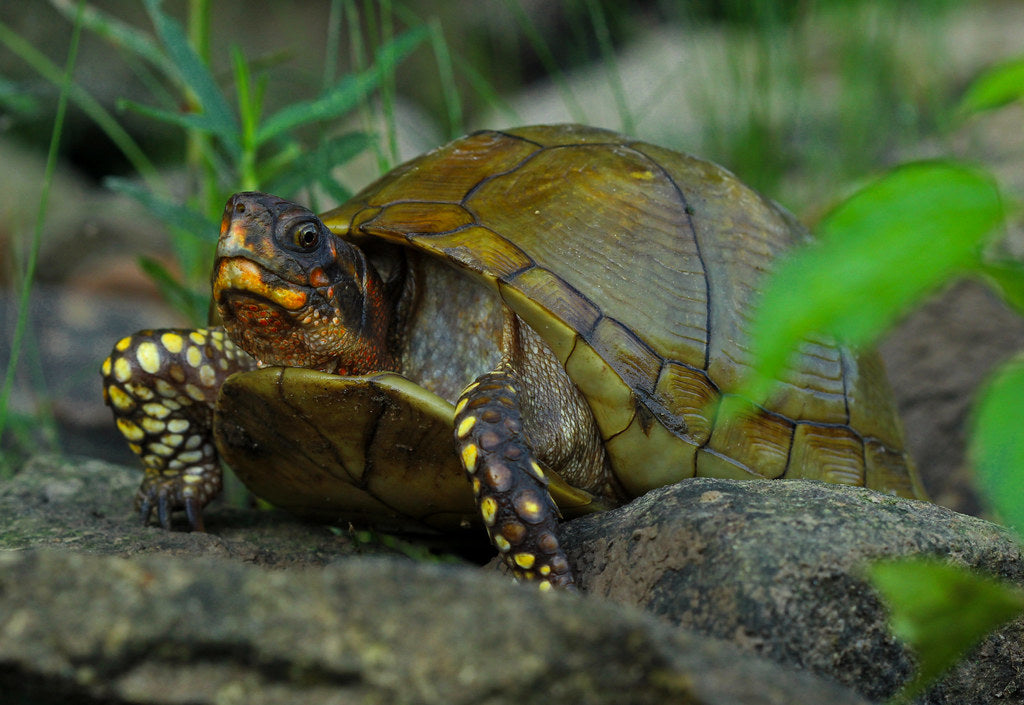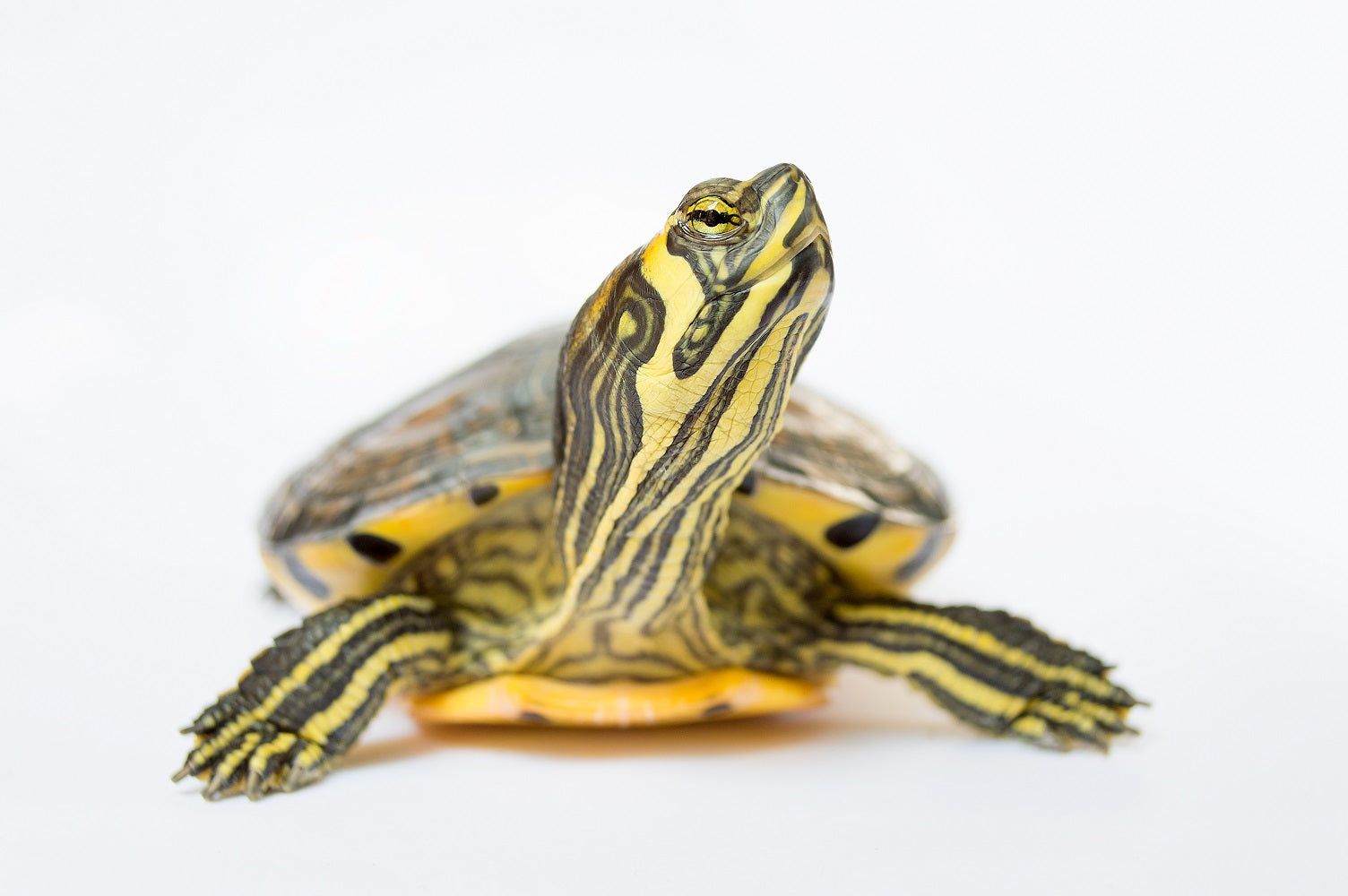Wood turtles (Glyptemys insculpta) are medium-sized, semi-aquatic, diurnal reptiles distributed unevenly throughout eastern Canada and the northeastern quadrant of the United States. They prefer riparian habitats where they spend time both on land and in the water.
Wood turtles are generally 5-8” long, although larger is possible. They have a blocky, tortoise-like head; flattened shell with prominent growth rings, large eyes, minimally-webbed feet, and enlarged scales on the forelimbs. Coloring is gray-brown on the shell, black on the head and legs, and yellow/orange/red on the neck and undersides of the legs.
Wood turtles have excellent dispositions that can make them entertaining, engaging pets.
Note: Wood turtles may be native to the US, but that is not a reason to take one from the wild! If you want a pet wood turtle, purchase one from a breeder instead.
How much space do wood turtles need?
The minimum enclosure size for appropriately keeping one adult wood turtle is 48”L x 18”W x 21”H. However, this is just the minimum, and providing a larger enclosure is both beneficial and appreciated!
Wood turtles spend a significant amount of time on land, so it’s best practice to use a Waterland tub or similar instead of an aquarium, so you can provide plenty of land area for roaming around, and moist soil for burrowing. This also provides a readily-available area of land for females to routinely deposit infertile eggs as needed (similar to a chicken).
Roughly 50% of the enclosure should be water. Water depth should be at least as deep as the turtle is long, preferably deeper. Despite the fact that this species doesn’t have webbed toes, they are strong swimmers.
Wood turtles tend to do well when housed outdoors where local climate permits, even if it’s just during part of the year. This is a convenient way to provide your turtle with a generously-sized pond and “free” heating and lighting.
Multiple wood turtles can be housed in the same enclosure as long as there is no more than one male per group, and the enclosure size is increased proportional to the size of the group.
Do wood turtles need UVB?
Wood turtles require regular exposure to high-quality UVB in order to maintain optimal health and wellbeing. Providing UVB lighting to your turtle gives them all of the vitamin D that their body needs, stimulates better appetite and activity, and strengthens the immune system, as well as other benefits.
The best UVB bulbs for wood turtles are:
- Zoo Med Reptisun T5 HO 5.0
- Arcadia Forest 6%
The UVB bulb should be half the length of the enclosure and housed in a reflective fixture like the Arcadia ProT5 or Vivarium Electronics. Place the lamp close to the heat lamp. If it’s on top of a screen lid, the basking platform should be placed so the top of the turtle’s shell is 6-9” from the lamp. If there is no screen obstruction, the lamp should be placed so the top of the shell is 11-12” below.
UVB bulbs decay over time, so don’t forget to replace your bulb every 12 months to maintain good performance. If you are housing your turtle outdoors in an appropriate climate, supplementary lighting is not required.
It’s also a good idea to provide a strong LED or T5 HO 6500K daylight lamp for additional illumination. This helps better replicate daylight and is also good for any live plants you may be using. “Nighttime” lighting such as colored light bulbs should not be used.
Lights should be on for 16 hours/day during summer and 9 hours/day during winter, with gradual adjustments in-between.
What basking temperatures do wood turtles need?
Wood turtles are ectotherms, which means that they rely on the variable temperatures of their environment to help regulate their metabolism and stay healthy.
Temperature gradient for wood turtles:
- Basking area (air temp) — 85-90°F
- Water temp — 60-70°F
Measure basking temperature with a digital probe thermometer, and water temperature with a high-quality aquarium thermometer.
A good way to warm the basking area is with a halogen flood heat lamp placed on one side of the enclosure and positioned over the basking area. Do not use ceramic heat emitters (CHEs), red bulbs, or blue bulbs, as these are not as effective. Increase the wattage if they’re too cool, and use a plug-in lamp dimmer if they’re too warm.
You will not need to heat the water. However, make sure to place the enclosure in a cool area of your home to help keep the water at an appropriate temperature.
If you are housing your turtle outdoors, supplementary heating should not be required. However, if your area experiences a significant drop in temperature during winter, you will need to make sure your pond is equipped to allow your turtle to hibernate safely (depth of >24”), or bring them inside once the weather starts to get colder.
What water conditions do wood turtles need?
The water in your enclosure should still be kept clean at all times in order to keep your turtle healthy. The most efficient way to do this is with a combination of excellent filtration and regular water changes.
Aquatic turtles are fairly messy creatures, so you will need a canister-style filter capable of handling at least 2-3x the amount of water in the enclosure. So, if you have an aquarium or pond with 40 gallons of water, you will need a filter rated for at least 80 gallons of water. Don’t settle for the cheapest filter you can find — this is one aspect of your turtle’s enclosure not to skimp on!
Once every 1-2 weeks, remove and replace approximately 30% of the aquarium/pond’s total water volume. This helps minimize buildup of toxic compounds in the water that a filter is unable to resolve. To make the job easier, use a siphon or water pump.
Both indoor and outdoor turtle ponds require filtration and water changes.
What substrate is good for wood turtles?
Roughly 50% of a wood turtle’s enclosure should be an easily-accessible land area for the turtle to climb up on, bask, and crawl around. Use a deep layer of moist, sandy soil for this area, particularly if the turtle is being kept outdoors. You can do this with Zoo Med Reptisoil or by mixing your own substrate with approximately 80% clean topsoil and 20% play sand (measured by volume).
Substrate is not required in the aquatic portion of the enclosure, although it does offer a form of enrichment when provided, encouraging natural behaviors. Fine sand makes for the best aquatic substrates for wood turtles. Avoid using gravel or small pebbles.
Leaf litter and sphagnum moss make good additions on the land.
What décor can you use in a wood turtle terrarium?
There are many ways you can increase your enclosure’s functionality and general attractiveness both on land and in the water. Here are some ideas:
- live/artificial plants
- driftwood
- hollow logs
- terracotta pots
Wood turtles are often found in bodies of water with a significant amount of woody debris, so branches may be a particularly useful décor item for this species. If you choose use artificial plants, they need to be sturdy enough not to come apart if the turtle tries to take a bite!
Make sure your turtle has access to places where it can hide from view as needed. Make sure objects with holes or tunnels in them are large enough to accommodate the turtle’s maximum size, as it can drown if it gets stuck!
What do wood turtles eat?
Wood turtles are omnivores, which means that they need to eat a balanced diet of both plant- and animal-based foods to get the nutrition that they need. Here is a general feeding schedule to follow:
Wood turtles younger than 6 months:
- 50% protein / 50% vegetables
- protein food or pellets daily
- vegetable food daily
Wood turtles between 6-12 months:
- 50% protein / 50% vegetables
- protein food or pellets every other day
- vegetable food daily
Wood turtles older than 1 year:
- 25% protein / 75% vegetables
- protein food or pellets 2-3x/week
- vegetable food daily
A portion of chopped/shredded vegetables should be roughly the same size as the turtle’s shell. A portion of pellets or protein food should be roughly the same size as the turtle’s head.
Animal-based foods for wood turtles: crickets, earthworms, dubias, freeze-dried shrimp/krill, frozen bloodworms, blackworms, silkworms, snails, guppies, mollies, platies, mosquito fish, crayfish
Vegetable foods for wood turtles: collard greens, dandelion greens + flowers, endive, green leaf lettuce, kale, red leaf lettuce, romaine lettuce, duckweed, filamentous algae, water hyacinth, water lettuce
Pellets for wood turtles: Omega One Juvenile Turtle Pellets, Omega One Adult Turtle Sticks, Tetra ReptoMin, Zoo Med Natural Aquatic Turtle Food, Mazuri Aquatic Turtle Diet
For extra calcium, your turtle should have access to a cuttlebone or calcium block at all times.
Do wood turtles like to be handled?
As a general rule, turtles do not like to be handled. Keep handling to a minimum unless it is absolutely necessary for inspection or transportation (ex: going to the vet for a checkup). However, wood turtles do seem to like interacting with their humans! Try hand-feeding it with a pair of feeding tongs and designing enrichment activities for regular interaction.
*This care sheet contains only very basic information. Although it’s a good introduction, please do further research with high-quality sources to obtain additional information on caring for this species.
"Wood Turtle, Glyptemys insculpta (LeConte, 1830)" by Misenus1 is licensed under CC BY-NC-SA 2.0




Leave a comment
This site is protected by hCaptcha and the hCaptcha Privacy Policy and Terms of Service apply.